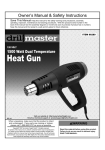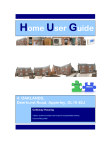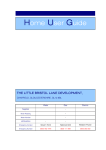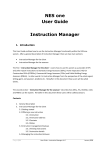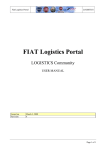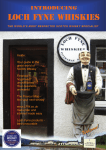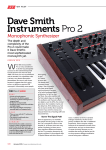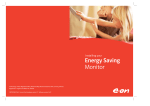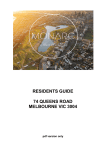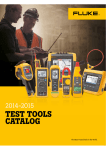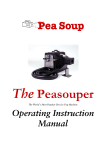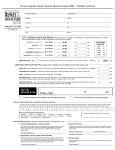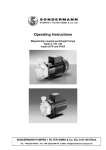Download Whole Doc - Bath and North East Somerset Council
Transcript
TENANTS INFORMATION PACK Meter Number GAS ELECTRIC WATER Meter Reading INDEX Page Number 1 Introduction/Welcome to your home 3 2 Quickstart 4 3 Report Problems 7 4 Insure your belongings 8 5 Security Lighting 9 6 Your garden 10 7 Boundaries 11 8 Electricity 12 9 Energy Saving 14 10 Gas 24 11 Water 25 12 Heating and Hot Water 26 13 Smoke and Carbon Monoxide Detectors 29 14 Running in 30 15 Minimising Cracking 31 16 Telephone 33 17 TV Aerial 34 18 Equipment 35 19 Security 39 20 Refuse (Collection/Bin Day) 40 21 Do and Don’ts 41 22 DIY 42 23 Troubleshooting 43 24 Fault Reporting Procedure and Defects 47 25 Useful Names and Telephone numbers 48 26 Contact Numbers and Links 49 27 Defects Rectification Timings 51 28 Travel 54 2 INTRODUCTION Welcome to your new home. You are now the tenant of a fully centrally heated new home. Each property has its own parking space for your use. Your home and its surroundings have been designed and built with great care and attention to detail. This handbook has been compiled as a guide to help you run your home and its equipment without problems and it also explains the reason why some things have been carried out in certain ways. 3 >INSERT ADDRESS< QUICKSTART ADVICE FOR RESIDENTS WELCOME TO YOUR NEW HOME As soon as you move in it is necessary to apply to various suppliers so that water, gas, electric and telephone are connected or not disconnected from your home. (They are normally connected when you move in but may be removed if you do not contact the Companies). Water Your water supply is metered. The meter can be found in the circular inspection chamber located in the pavement just outside your home. The stop tap is located in the cupboard under the kitchen sink. Your water provider is Wessex Water. Electric Your electric meter is located in the wall to the front of your house. The fuse board/consumer unit can be found in the hallway. Please note that the fuse board in your new home is very sensitive, for your safety, and if any of your own appliances have a fault, however slight, the fuse will “trip” cutting off the electricity supply. In some cases this happens even when a light bulb fails and all you need to do is reset the “trip” on the consumer unit. If it “trips” again it is most likely that there is a fault in a fitting or appliance that has been fitted by you rather than the installation. Gas The gas supply enters your home through the gas meter located in the brown semi-recessed meter boxing, which is at ground level to the front of the building. The gas supply can be turned off by via the gas shut off valve, which is located in the gas meter box. 4 Refuse and Recycling A recycling bin has been installed in your kitchen. The Local Authority will collect general refuse fortnightly. It will help the environment if you separate recycling refuse and store it in separate bags, for a separate collection by the council, which for recycled refuse is carried out on a fortnightly basis. For more details of the types of refuse that can be recycled please go to; …………………….INSERT WEBSITE……… Postal Code Your new Postal Code is ……… Decorations During the first 12 months the Builder is responsible for repairing major cracks and other faults. However, if you decorate before he has made good these cracks he may not be able to match your colour scheme. You may not decorate the property without the consent of Curo. Consent will not be given within the first 12 months. Similarly we recommend that you do not fit laminated flooring for the first few months as it may be damaged if there is a leak. User Manual The remainder of this “HOME USER PACK” contains a large amount of information that will help you operate and maintain the equipment in your new home. It also advises you of ways of avoiding problems and how to save money. Take time to read it and know where to find it when you need it. Please keep the handbook safe – it must be returned to Curo at the end of your tenancy. 5 Defects While every effort has been made to ensure that your home is free from any problems, like a new car, faults unfortunately can occur. Having carefully checked that it is not something simple, like a failed bulb, the boiler is switched off or it is something covered by your User Manual, please contact …….INSERT TELEPHONE NUMBER……….. who will arrange for the Contractor to return to site and rectify the fault. In the case of emergencies outside normal working hours you should contact …….INSERT TELEPHONE NUMBER……….. 6 REPORT PROBLEMS All problems should be reported initially to Curo during office opening hours On 01225 366111 Or in emergency out of hours On 0345 245 0566 Do not be afraid to tell us if you have any problem. If you are not sure about your problem, just telephone the number at the top of the page and we will happily talk you through the problem and make sure that it is put right. 7 Insure your belongings Curo does not insure the contents of your home or your personal possessions. The association cannot be responsible for these in any way. You should arrange a comprehensive insurance policy to cover you for fire, burglary, house break-in, storm and flood damage and other risks as soon as you move in. Curo do offer a scheme through ‘Home Plus’ that you can take advantage of. Details are contained in your tenants’ sign-up pack. 8 SECURITY LIGHTING An external quality light fitting is mounted on the wall next to the main entrance door. The fitting is operated with a motion detector device, which detects bodies approaching and will automatically switch the light on when people approach the door. The light will also switch itself off after several minutes. The external areas will also be lit by security lights fitted with motion detectors in line with the Secure by Design requirements. 9 YOUR GARDEN The garden area is yours to enjoy, but please do not move or adjust the planting in your garden without consulting your Housing Officer. The planting scheme is a planning condition and if we have to replace any planting that you have removed, you will be charged. There is a 12 month Maintenance Defect period for all the new Landscaping on the development commencing from ….INSERT DATE….. Please ensure that newly laid turf is watered regularly to avoid it dying, especially in the summer months 10 BOUNDARIES Your boundaries and fences should be clearly defined, if you have a query about the boundaries of your home or the location of your parking space(s) please contact Curo. If you have a problem with the planting, boundaries or fencing please contact Curo On 01225 366000 11 ELECTRICITY Your consumer unit is located in the cupboard off the hallway and identifies all the lighting and power circuits. Your Electricity Meter is located in the storage cupboard in the entrance hall. Each circuit protected by a miniature circuit breaker or MCB. These breakers are easy to re-set by flicking the switch back to the on position. In addition to the MCB’s there are switches called residual current devices or RCD’s, these devices isolate the supply to the whole house Circuit breakers are generally more sensitive than fuses and may well trip out even when a light bulb fails, or you are using an appliance with an electrical fault or faulty plug. Remember that electricity can kill. Do not attempt to do any work on an electrical circuit or appliance, unless you are suitably qualified. >INSERT NAME OF SUPPLIER< is the current electricity supplier to your property If you or your neighbours have no electricity supply please call the emergency number below. >INSERT NAME OF SUPPLIER< >INSERT TELEPHONE NUMBER< 12 REMEMBER THAT ELECTRICITY IS DANGEROUS AND CAN KILL, SO: DO NOT attempt to do any work on an electrical circuit ALWAYS ensure that appliances are fitted with the correct fuse as recommended by the manufacturer. ALWAYS unplug any appliance before working on it. ALWAYS follow the manufacturer’s instructions for wiring appliances. DO NOT use a portable electric fire in the bathroom (the heating installed should be sufficient for you not to need portable heaters any way). NEVER use an electrical hair dryer or any other portable electric appliance in the bathroom except electric shavers supplied from a special shaver unit. Keep a torch handy by the control box for emergencies: never use matches or a cigarette lighter. DO NOT attempt to repair, alter or extend electrical installation. Earth bond clamps with green/yellow cable are connected to equipment at various positions, for example, incoming services, sink top, bathroom, etc. These are for your safety and must not be interfered with or disconnected. 13 ENERGY SAVING Your new home has been designed to meet the Building Regulations Standard of Thermal Insulation by insulating the roof space and external walls, and installing double glazed windows. This helps to reduce the amount of fuel you need to keep comfortable warm. In addition your house has been fitted with solar panels to provide a renewable source of energy to your home. The heating should, under normal conditions, be set to achieve an indoor temperature of between 17 and 20oc (63 to 68of). Remember the warmer the room, the more it is costing. In each dwelling energy saving light fittings complete with low energy lamps have been provided. All other light fittings, excluding the florescent fitting to the kitchen and bathroom are lamped with low energy bulbs. There are now more good reasons than ever to buy energy saving light bulbs. 1. Overview Energy saving light bulbs have always been a bright idea for your pocket and the environment. They use up to 80 per cent less electricity than a standard bulb, but produce the same amount of light. In other words, they can help you to save money and energy, all in one wise purchase. And by saving energy, you'll be helping to fight climate change too. In our light bulb Pepsi challenge we found that half of the people could not spot the difference between traditional light bulbs and energy saving ones. 14 Read about the light bulb Pepsi challenge That's the good news. Now, here's some more. Technology's moved on a lot since energy saving light bulbs were first invented, and so has the way they look. In fact, whatever types of bulbs you use to light your home, there are sure to be stylish energy saving equivalents. So, why not switch to energy saving light bulbs today? As you'll see, even the best excuses no longer apply. The phase out of inefficient light bulbs You may have seen in the news that inefficient light bulbs are being phased out - click here to find out more about the phasing out of inefficient light bulbs See energy saving bulbs in a new light In your mind's eye think of an energy saving bulb, is it bulky and oddly shaped? Maybe giving off a cold, harsh light? If so, be prepared to think again. There are now more good reasons than ever to buy energy saving light bulbs. Here are some of the best. Advances in technology mean that energy saving light bulbs are now available in a wide variety of fittings, shapes and sizes. Like standard bulbs, they come in all shapes and sizes These range from stick shaped bulbs candle shaped varieties, with small or medium screw and bayonet fittings. The choice really is yours. Nowadays, there are even halogen and dimmable energy saving bulbs on the market. And thanks to the invention of 'soft tone' bulbs, you can enjoy a warm glow rather than a cold light. 15 They're just as bright as normal bulbs, but better for the environment... Simple fact: energy saving light bulbs use less electricity than standard bulbs to do the same job. In turn, using less energy like electricity means that our homes produce less carbon dioxide: one of the main causes of climate change. So, why not do your bit to help fight climate change? Next time you need a bulb, buy an energy saving one. You can now buy low energy light fittings which will only take low energy light bulbs. These use a ballast or transformer fitted into the base of the light fitting. It controls the supply of electricity to the bulb, allowing for a small surge of power for a millisecond to light the bulb and then reducing the electricity flow to a very low level. Low energy fittings require a pin based energy saving bulb. This is a different fitting to a conventional bulb but will ensure that the bulbs you buy in future will always save energy, money and the environment. 2. Benefits Depending on how long your lights are in use every day, just one energy saving light bulb could save you on average around £3 a year, and up to £6 for brighter bulbs or those used for more hours a day. And because it will last up to 10 times longer than a standard bulb, it could save you around £45 before it needs replacing. Fit all the lights in your house with energy saving bulbs and you could save around £50 a year and £675 over the lifetime of all of the bulbs. And before you ask, these savings take into account the higher cost of energy saving light bulbs. These days, the average price is around £2 a bulb, so you'll usually recoup the extra outlay within a year . Energy saving light bulbs use a fifth to a quarter of the electricity of ordinary bulbs to generate the same amount of light. So where you'd normally use a 60W bulb, you'll only need a 13-18W energy saving recommended equivalent. 16 Ordinary bulbs Energy saving equivalent 25W 6W 40W 8-11W 60W 13-18W 100W 20-25W 3. Suitability - are they suitable for my home? Don't stay in the dark You're bound to still have some questions about energy saving light bulbs. We've answered some of the most common queries - and shattered several popular myths along the way. Click here to see the frequently asked questions about energy saving lighting 4. What to look for when buying energy saving lightbulbs When you're shopping for energy saving lightbulbs, look for the Energy Saving Recommended logo. It's the quick and easy way to spot the most energy efficient products on the market. If a lightbulb carries the logo, it means it's met the strict energy efficiency criteria set by the Energy Saving Trust and has been independently tested by an independent accredited test house. As well as energy consumption, criteria for lightbulbs cover how long they should last, quality of light, packaging information and safety. The criteria are reviewed on a regular basis and standards are constantly being raised to make sure that energy saving bulbs keep on improving in terms of efficiency and performance. So, by buying an Energy Saving Recommended bulb, you can be sure it will not only save energy but also be of the highest quality. 17 Always look for the Energy Saving Recommended logo Find Energy Saving Recommended lightbulbs 5. Help and support - Get more advice on energy efficiency Call your local Energy Saving Trust advice centre on 0800 512 012 for free, impartial advice on making your home more energy efficient. Click here to find out more about our local advice centres. RESPONSIBLE PURCHASING Did you know? A large chest freezer that is 10 years old is probably the single biggest electricity consuming appliance in your home! An 'A' rated dishwasher uses 27% less electricity than an equivalent 'C' Rated appliance! An 'A+' rated cold appliance uses 56% less electricity than an equivalent 'C' rated one! How do new white goods compare to older models? If your current appliances are more than 10 years old, you could save the following in electricity bills, simply by upgrading to a new, energy efficient model. The table below gives an indication as to the typical savings that can be made: Fridge freezer Upright/Chest freezer Fridge Washing machine Dishwasher Energy Rating A – A** Average savings per year* £40 A – A** £35 A – A** A A £23 £6 £17 18 *All information is based on replacing an average appliance purchased from new in 1990 with a similar size 'A' rated model and electricity cost of 7.9p/kWh. Note: Cost Savings are only to be used as a guide. Did you know? The average UK household does approximately 300 washes a year! What you get for your money – Energy Efficiency The more efficient the product, the less energy it needs and the more you get for your money. ‘A’ rated products are the most efficient and ‘G’ rated products are the least efficient. Use the main ‘A - G’ scale to compare different models. How much will it cost to run – Energy Consumption? This tells you how much electricity the product uses, in kilowatt hours (kWh)*. You can use this information to work out how much electricity and money you might save if you chose a different model. Less electricity use is better for the environment. *This is a unit of electricity. When you buy electricity, your supplier charges you for how many kWh or ‘units’ you use. A one bar electric fire uses 1kWh in one hour’s use. A 100watt electric light bulb uses 1kWh in 10 hours’ use (an energy saving light bulb would go on for 40 hours on 1kWh of electricity!).duct details. Product details Actual savings will, of course, depend on how you use the product and how much you pay for your electricity. You can also save money by loading washing machines, washer-dryers and dishwashers fully, using economy and low temperature settings, and spin-drying clothes well before you tumble dry; by ensuring that fridges and freezers are installed away from cookers and 19 other sources of heat in accordance with the manufacturer’s advice; and by switching off lights when not needed. Manufacturer’s name and product details This confirms the manufacturer’s name and model number - check that this is the same as the model you actually choose to buy. The European Ecolabel Some products may be awarded the European Ecolabel which may appear on the label or elsewhere. The Ecolabel indicates that the product has been independently assessed and found to meet strict environmental criteria (considering more than just energy consumption), putting it among the best in its class. How well does it perform? How well does it perform? (washing machines, combined washer-dryers and dishwashers) The ‘A-G’ indicators here are similar to the main energy efficiency ratings and are based on European standards (the test cycle used is on the label): ‘A’ is the best performance and ‘G’ is the worst performance. For example, a washing machine that has a good spin-drying performance will save you money and time, if you choose to tumble dry the clothes, on tumble drying. Water consumption, conservation and efficiency (washing machines, combined washer-dryers and dishwashers). Water consumption Some models use more water than others, but more water doesn’t mean better performance. 20 Water conservation To help you choose a water efficient model, the table below shows roughly how much water typical appliances use. Washing machine: 30-100 litres per wash programme (based on a wash load capacity of 5kg) Washer-dryer: 60-200 litres per wash and drying programme (based on a wash load capacity of 5kg) How well does it perform Dishwasher: 10-30 litres per wash (based on an 8-place setting) Dishwasher: 10-50 litres per wash (based on a 12-place setting) Water efficiency Choose a model that uses water more efficiently. For example, buying a washing machine that uses 30 litres per wash rather than 100 litres could save an average family about £20 per year on a metered water bill and reduce their water consumption by about 1,500 bucketfuls. Noise Manufacturers don’t have to provide information on noise - and most don’t. If shown, the lower the number, the quieter the appliance. Lamps The label design is simpler than for other labelled appliances. In addition to the standard ‘A-G’ scale for energy efficiency, the label provides information on the luminous flux of the light bulb in lumens, the input power of the light bulb in watts and the average rated life of the light bulb in hours. 21 No labels? Ask your retailer first - he must, by law, provide this information. Local authorities in England, Wales and Scotland are responsible for enforcing the regulations that cover energy labels and similar energy information in mail order catalogues etc. Enforcement in Northern Ireland is the responsibility of the Trading Standards Service of the Department of Enterprise, Trade and Investment. To obtain contact details for your local Trading Standards Department, click on http://www.tradingstandards.gov.uk and enter your postcode. Further information To find out more ways to save money on your energy bills and choose efficient appliances, look on the Energy Saving Trust’s ‘Save Energy’ website at http://www.saveenergy.co.uk. SAVING WATER IN THE HOME Water is an important source and all of us can be guilty of needlessly wasting water. Here are a few tips on how to save water in and around the home, which could reduce wastage and costs. Any Leak is a waste – get it fixed! Check all taps to ensure none are dripping. Check for leaks under the sink, basin, bath and associated pipe work. Check the WC bowl for signs of any continually running water. If you see water running from an external overflow pipe, report it straight way, as you may have a fault with a ball cock system not closing properly allowing water to run freely. 22 Check all outside taps and pipe work are protected from frost and tanks and pipe work in loft spaces are properly insulated. Take a shower instead of a bath. Only fill kettles with the amount of water needed. Don’t leave the tap running when you are brushing your teeth. Use a bucket and sponge to wash the car, rather than a hosepipe. Wash vegetables in a bowl rather than under running water 23 GAS Your Gas meter is located in the Brown Meter Box located at the front of the building and this is where you turn your gas off >INSERT SUPPLIER< is the current gas supplier to your property. Any work on the gas installation must only be carried out by ‘Gas Safe’ registered persons. IF YOU SMELL GAS: DO NOT switch any lights or equipment on DO turn off the gas supply at the meter DO open the window DO telephone the Gas Emergency number 0800 111999 to report a leak 24 WATER >INSERT SUPPPLIER NAME< Water is the current water supplier to your property. When you move in you should contact them on >INSERT TELEPHONE NUMBER<in order to set up your billing account. Turn off your water here You will find the stop tap located in the cupboard under the kitchen sink. The connections for a washing machine are under the kitchen sink. We recommend that a qualified engineer install your washing machine. >INSERT NAME< is the water provider to your property. >INSERT NAME< Emergency Number >INSERT NUMBER< Tips to remember: If you intend to leave your house for more than a day or two in winter, you should leave the heating set on a low level to avoid freezing. If there is a risk that pipes are frozen do not run the hot water taps as this will empty the hot water cylinder which could then collapse. Do not allow taps to drip as a dripping tap may stain the bath or basin and could result in frozen waste pipes in winter. 25 HEATING & HOT WATER HEATING Your home has a Gas fired condensing combination boiler located on the wall of your kitchen to meet the demands of heating and providing hot water to your property. From this, hot water is circulated to the radiators in each habitable room via distribution pipework located under the floors. A programmeris situated in the hallway which allows you to control your hot water and central heating. 26 Once full with water and with the automatic controls correctly set, the heating system should need little attention other than periodic inspection and maintenance; the latter will be arranged by the Repairs & Servicing Department. HOT WATER Hot water is supplied from your boiler. Its temperature can be altered via the control panel on the boiler. This will have been set at the normally accepted temperature during commissioning and should not need adjusting. 27 OPERATING INSTRUCTIONS FOR THE CENTRAL HEATING These notes explain how to start and stop your central heating and hot water system, they also explain how to operate your boiler and its controls to give you the results you require. Do not be influenced by the advice of friends or neighbours, the setting of the controls of a central heating system is a personal option, their system may not be exactly the same as yours and results obtained may not suit your requirements. Should the heating or controls cease to function and you are not sure about correct operation, turn off the heating system boiler using the on/off switch and then switch off the electrical supply at the switch next to the programmer and contact Curo. If a gas leak is suspected, turn off the gas supply at the gas meter and call the emergency number 0800 111 999 YOUR SYSTEM CONTROLS SHOULD BE SET AS FOLLOWS (a) Refer to the boiler user’s instructions. (b) Room stat set to desired temperature, but note that the thermostat temperature setting shown is not precise and should be adjusted for your own comfort. (c) Programmer - your programmer has the ability to set the times you want both your central heating and hot water systems to be operational. The user’s guide will explain how to set up the programmer to suit your personal requirements. (d) Hot Water Temperature - this will be set up before you move into your home and should not need adjusting. 28 Smoke/Carbon Monoxide Detectors FIRE ALARM INSTALLATION Your home is fitted with a mains fire alarm system, which has been installed for your safety. There are several detector heads installed, they are generally located; in the hallway area, the living room and in the kitchen area. There is also a CO2 detector head fitted in the kitchen, which will detect any carbon monoxide fumes in the unlikely event of it leaking from the boiler. A fire alarm system is also fitted in the hallway, which in the event of a fire will activate an alarm within your property. Regular maintenance of both the boiler and detector will ensure your safety. Think about escape routes Now!! Carbon Monoxide detector 29 Smoke detector The system control/indicator panel is powered by a dedicated electrical supply together with an integral backup battery and charger unit. The manual for all instructions and information for operating the fire alarm and carbon monoxide detectors can be found in the tenants handover pack. The detectors are sensitive to dust and you should periodically remove any dust with the nozzle of your vacuum cleaner. 30 RUNNING IN If you are the first resident to move into a new property you should be aware that the Building Contractor who did the work is responsible for any construction defect that may occur during the first year after the work was completed. Your home will be drying out during the first year and shrinkage cracks will appear. This is normal and at the end of the first year we will arrange an inspection of your home with you and the Building Contractor. The Contractor will be given a list of all the defects and they will arrange access with you to remedy the defects. Common defects are: Cracks in plaster Broken ironmongery Faulty windows and doors Do not be afraid to tell us if you have any problems. However, it would assist if you do not report defects, except emergencies, on a Friday afternoon as we may not be able to attend to it before the weekend 31 MINIMISING CRACKING Gentle heating Try to keep your house at an even temperature and allow your house to heat up gradually. Ventilation Leave windows and internal doors open as much as possible. Leave your window vents open. Keep kitchen and bathroom doors closed when cooking or bathing and leave a window open. Leave a space between large pieces of furniture and the external walls. Do not overfill your cupboards, as this will prevent the air circulating. KITCHEN 32 Produce Less Moisture Cover pans when cooking and do not leave kettles boiling. Do not dry clothes on radiators or on clothes dryers. If you install a tumble drier ensure that it is either a condenser type or is directly ventilated to the outside air. 33 TELEPHONE Your home is provided with a British Telecom socket to the living room and bedrooms. You should contact your selected service supplier in order to become a subscriber, as you are responsible for any connection charges. 34 TV AERIAL Houses TV aerial points are provided in the living room and all bedrooms, a cable connects these sockets to an aerial in the roof space (an aerial is not provided).You will need to arrange for a specialist to install an aerial and provide your own coaxial cables to connect your TV to the wall point. 35 EQUIPMENT Kitchen The kitchen is equipped with a range of base units and wall units, a stainless steel sink unit, together with laminated worktops and tiled splashbacks. 13A sockets outlets have been provided for your electrical appliances. Spaces have been provided for an electric/gas cooker, a fridge/freezer and washing machine (switches controlling the socket outlets for these appliances are located above worktop level). Hot and cold water supply and drainage facilities have also been installed in or adjacent to the washing machine space. IF IT IS YOUR INTENTION TO INSTALL A DISHWASHER THE CONSENT OF CURO WILL BE NEEDED. A QUALIFIED TRADESMAN SHOULD INSTALL THE PLUMBING AND WASTE. ANY DAMAGE CAUSED BY THE WORK IS THE RESPONSIBILITY OF THE TENANT To clean kitchen units and worktops use a cloth soaked in warm soapy water. Never use abrasive materials, as this will damage the surfaces. Never cut food or other materials directly on the worktops, always use a cutting board. CURO RESERVES THE RIGHT TO RECHARGE FOR DAMAGE CAUSED. Bathroom/WC The bathroom is equipped with a washbasin, WC and pressed steel bath, with an over the bath shower and curtain. Tiled splashbacks are provided to the basin and bath. There is an extractor fan for ventilation to reduce condensation. This runs automatically so long as the main 36 switch for the extractor fan is on. This switch is located outside of the bathroom to the side of the door. Doors and Windows Doors – The front entrance door is of secured by design standard and fitted with a BS standard multipoint locking mechanism operated by a key from the outside and the thumb turn from the inside. The door is also supplied with a door viewer and security chain. The French door is also secured by design standard and fitted with a BS standard multipoint lock. The bathroom door is fitted with lever handles and a bathroom lock, which is the case of an emergency, can be opened from the outside. Windows – The windows are white PVCu double glazed units, fully weather stripped, fitted with easy clean hinges, lockable handles to the ground floor and restrictors to first floor windows. To clean window frames use a cloth soaked in warm soapy water or a specialist PVCu cleaning product. Never use abrasive materials, as this will damage the surface. USEFUL INFORMATION Fixing to a wall The walls in your house are finished with plasterboard. Care needs to be taken when making fixings to plasterboard walls. Very light items may be fixed by using adhesives to the manufacturer’s instructions, but be careful – the bond can be no stronger than the adhesion of the paint to the wall and if you decide to remove the item in the future you may damage the paintwork or the plasterboard. Pictures, if not large, and other small items may be hung on picture hooks, either single or double nail types. Heavy pictures and mirrors should not be hung on picture hooks. Instead use a special wall plug fixing specifically designed for fixing to plasterboard. The special wall plugs 37 (sometimes referred to as butterfly fixings) are available from hardware and DIY shops. If fixing through wall tiles keep the end of the wall plug level with the plaster face and not the face of the tile. The walls in the bathroom have been reinforced with ply to enable the future installation of mobility aids such as grab rails and hoists. Fixing to Ceilings It is possible to fix items to the ceiling but you should take care not to suspend heavy objects from the ceiling. The ceilings are constructed using plasterboard fixed to floor joists or on the first floor to the underside of the roof trusses. These will normally be spaced about 400mm apart and can be located by tapping across the ceiling. If you can locate these you can drill through the plasterboard into the wood and use a woodscrew in the normal way. If you cannot find the timber you may fix lightweight items by using toggle bolts or plugs designed for hollow partitions. Be careful when nailing or drilling into walls, floors or ceilings to avoid contact with any electric cables or pipes that may lie beneath the surface. Do not drill either vertically or horizontally in line with an electric socket or light switch and always check in the next room if you intend fixing to a partition. Blockages Kitchen waste pipes – If a blockage occurs and the sink is full of water try to remove the blockage by pushing a flexible rod down the plughole or by using a suction cup plunger to force water up and down the waste pipe. The risk of blockages can be reduced if you remember to put fat that solidifies when cold into an empty tin or milk carton rather than down the drain. Baths and Basins – Blockages here are normally caused by a build-up of hair and soap and become noticeable 38 when the bath or basin start to drain away more slowly. Use a suction cup plunger as for the kitchen sink. WC’s – Never flush disposable nappies or similar items down the toilet as these can cause a serious blockage for which you will need the service of a drain cleaning company to clear. If blockages are found to be caused by disposable nappies, etc the cost will be recharged to the tenant. Sanitaryware Baths, basins and sinks should be cleaned with recommended products to avoid damaging surfaces. Do not use scouring or gritty cleaners. Bleach should not be mixed with lavatory powder nor allowed to stand in stainless steel sinks. Redecorating Redecorating can be carried out following the 12 months maintenance inspection when the contractor will repair any defects. The builder will repair only very large cracks that may form during the first 12 months. Smaller cracks in plaster or paintwork can be made good with filler prior to decorating. First floor joists The joists supporting the floor to the bedrooms and bathroom are special TJI joists. Under no circumstances must you cut out or notch these joists, for example if you wish to conceal wiring under the floor. If you do this you will weaken the structural support which can be dangerous. 39 SECURITY 1. Do not allow strangers into your home without asking for proof of identity and being satisfied with that identity. 2. Whenever you leave your home – even to visit a neighbour for a short time, make sure your entrance door and all windows are secured. The two point locking handles on the windows will enable you to lock the window and still leave a small gap for ventilation. 3. Never leave valuables where they can be seen by looking through a window. 4. Hide small valuable items like jewellery. 5. Make sure that the contents of your home are adequately insured against fire and theft and that any terms about declaring valuables are complied with. 6. Have valuable items photographed and use the new marking methods available so that your goods can be traced if stolen. 40 REFUSE COLLECTION/BIN DAY IDENTIFY WHERE REFUSE WILL BE COLLECTED >INSERT LOCAL COUNCIL< collect your general refuse which should be placed on the kerbside before 7am on the day of collection, ready to be picked up. It will help the environment if you separate recycling and store it in the bins provided in the kitchen, to then be placed out on the day ready for collection. For more details of the types of refuse that can be recycled please go to:->INSERT WEBSITE ADDRESS< Refuse is currently >INSERT< and is collected on a >INSERT< Recycling is collected >INSERT< which is on a >INSERT< For full details of collections ring >INSERT NUMBER< The Council offers a bulky domestic waste collection service for the removal of bulky items from outside your home that are not collected through the weekly service. Please note this service includes the collection of fridges and freezers. The service has been created to help people who cannot take for example the larger items of furniture, household &garden equipment, and fridges to the Recycling Centres. There is a charge for this service. See >INSERT WEBSITE< or call the number above for further details. 41 Do’s and Don’ts Do ventilate your home properly. Avoid drying clothes indoors. Do close the door when cooking or bathing to restrict moisture Do not use your roof space for storage. Do wipe down kitchen and bathroom surfaces after use to remove surplus water. 42 DIY While your new home is your home there are rules as to what you can and cannot do to your home. You are allowed to decorate your home to your own choice but you should remember that when you leave the home it should be in as near to the existing condition as when you move in. You are advised not to decorate during the first twelve months after your home was built as the Contractor will not be able to match the paint colours should there be any cracks etc that need to be made good. You are allowed to hang pictures on the walls along with shelves and cupboards. Your home is constructed of timber frame lined internally with plasterboard and appropriate fixings should be used. Consult your local DIY store if in doubt. You should be aware that any fixings on the external walls if installed incorrectly will puncture a vapour control layer which will affect the insulation of your home. You are not allowed to remove any fixture, wall or door. Any alterations to plumbing and or electrical fittings must be carried out by a competent professional tradesperson. Before you undertake any alteration or addition you should discuss this with the Association who may require a written application complete with all details of the proposed works. When buying materials for your home and garden please be aware of environmental matters and use materials that are not harmful to the environment. 43 TROUBLE SHOOTING Checks to be made before calling Curo. Check the following - you may not need to call Curo Service Centre having followed this advice. However, you may find that having this information to hand when you contact Curo useful. Plumbing IF BOILER DOES NOT WORK AT ALL – GO THROUGH THE FOLLOWING CHECKLIST Is the boiler making any noise? You should not be able to hear any noise. Is the electricity turned on? Check the switch on the wall is switched on and that there is credit on your meter? Is the gas turned on? Is there credit on your meter? Is water available at the boiler? Are the stopcocks open? Is the clock selector switch set to continuous? Or is the timer still set? Change the setting. Is the RED ignition light on? If no, contact your Customer Service Centre 44 Hot water but no heating – Is the boiler turned on Is the room thermostat switched on? Turn the dial clockwise, to maximum. Is it turned up fully? If not turn it up further. Is there a clock fitted? What time is it set for? Is the clock selector switch set to continuous? Or is the timer still set? Are the radiators turned on? Turn the radiator valve clockwise, to maximum. Is the radiator hot only at the bottom Bleed the radiator of air with the key provided. Open gently until air can be heard escaping close quickly as soon water appears. You will find it useful to have a towel ready as the water may be dirty and mark your carpet If you still have no heating then please ring Curo. 45 Electrical You may find that from time to time, one of the MCB “trips out” on the board. This will generally be due to a fault on one of the circuits, an appliance or it may occur when a light bulb blows. This is designed to happen as a protection device and should not cause concern. Each of the circuits in your property is on a separate MCB; lighting will be on one MCB, sockets will be on another etc. and are clearly labelled - lights, shower, cooker etc. When one of the MCBs “trips out”, it can easily be identified as the one showing “OFF”. To restore the power, it is just a matter of lifting the switch on the MCB back to the “ON” position. If it “trips out” again, please follow the procedures set out below. Turn off all appliances or lights in the affected circuit. Re-set the switch on the board to “ON”. If it won’t reset unplug all of the appliances on the circuit. Turn back on all of the lights or appliances one by one. If the MCB “trips out” again, as you turn back on an appliance or light, it will mean that the appliance or light is faulty and is causing the MCB to trip out. If this happens, simply turn off the light and replace the bulb or turn off and unplug the appliance that caused the MCB to trip and again re-set the MCB, you will then be able to continue to use the remaining lights and /or appliances on that circuit. The faulty appliance or light should not be reconnected unless it has been examined and repaired by a qualified electrician or the appliance has been replaced. If the fault is due the electrical installation to the property during the Defects period please report this to Curo, during normal office hours. Residents should note that if the fault is with a normal domestic appliance, the repairing responsibility lies with the resident. 46 Please take care to ensure that any electrical appliance you use is suitable for connection to a 240 volt 50 cycle AC supply. Ensure it is safe and in good working order and that a fuse of an appropriate rating is installed in the plug of the appliance (please see fuse guide below). If you have doubts about any appliance you should seek advice from a qualified electrician. 47 FAULT REPORTING PROCEDURE & DEFECTS General Defects Although your home has already been inspected and passed, it is possible that unforeseen defects may occur during the first year since completion. Should you encounter such problems please advise Curo Customer Service Centre, who will ensure that swift action, is taken to inspect and remedy them if necessary. Please take time to read the trouble shooting items before you report a defect to ensure that time and money is not wasted. The defects period does not cover general wear and tear. For your information, building defects will be passed onto either the Oval Homes dedicated maintenance team for them to action. Our response times should mirror those set by Curo. Defects Inspection Approximately twelve months after completion of the building works, an appointment will be made with you and your home will be jointly inspected by Curo and an Oval representative to identify any defects that may still be outstanding and require rectification. Your co-operation at this stage will be appreciated. It is useful at the inspection to have prepared a list of the items you feel are covered during the defects period to ensure that all items are addressed. You are asked not to re-decorate your property until this maintenance period has elapsed and any defects corrected as we are unable to match any changes in the colour scheme. 48 USEFUL NAMES AND TELEPHONE NUMBERS Water Authority Customer Billing enquires for >INSERT NAME< – Tel: –>INSERT NUMBER< >INSERT NAME< (Sewerage) – Tel: –>INSERT NUMBER< Electricity >INSERT NAME< (electricity supply) –>INSERT NUMBER< You may use another supplier of electricity if you prefer. Telephone British Telecom - Tel: 0800 800150 – Non BT Phone Freephone 150 – BT Phone Gas >INSERT NAME< (gas supply) –>INSERT NUMBER< You may use another supplier of gas if you prefer. 49 CONTACT NUMBERS & LINKS Landlord: Curo The Maltings River Place Lower Bristol Road BATH BA2 1EP Tel: 01225 366000 Web: www.curo-group.co.uk Contractor: Markey Construction (Gloucester) Ltd Unit Q1, Quadrant Distribution Centre Hardwicke GLOUCESTER Gloucestershire, GL2 2RN Tel: 01452 886 155 Fax: 01452 886156 Email: [email protected] Web: www.markeyconstruction.co.uk Local Authority: Bath and North East Somerset Council (BANES) The Guildhall High Street Bath BA1 5AW Tel: 0300 456 0100 Email: [email protected] Cycle Networks: Sustrans Information Line Tel: 0845 113 00 65 Email: [email protected] Web: www.sustrans.org.uk WRAP: The Old Academy 21 Horse Fair Banbury OX16 0AH Tel: 01295 819 900 Web: www.wrap.org.uk 50 The National Energy Foundation: Davy Avenue Knowlhill Milton Keynes MK5 8NG Tel: 01908 665555 Fax: 01908 665577 Email: [email protected] Web: www.nef.org.uk/energyadvice/lighting.htm DEFRA: Information Resource Centre Lower Ground Floor Ergon House c/o Nobel House 17 Smith Square London SW1P 3JR Tel: 08459 33 55 77 Email: [email protected] National Energy Centre: Davy Avenue Knowlhill Milton Keynes MK5 8NA Tel: 01908 672787 Fax: 01908 662296 Email: [email protected] Web: www.nesltd.co.uk Energy Saving Trust: 21 Dartmouth Street London SW1H 9BP Tel: 0800 512 012 Fax: 020 7654 2460 Web: www.energysavingtrust.co.uk 51 Defect Rectification Timings and Examples. Emergency Repairs (priority Code 1) As soon as possible and in any event within 24 hours in respect of the breakdown of vital services or serious defects involving a risk to tenants or the building. Urgent Repairs (Priority Code 2) Within 7 days in respect of defects which are not a positive danger but cause some inconvenience to tenants or staff, and which may develop into a more serious defect if left unattended which while necessary , does not affect the immediate users of the building and which may be carried out when operatives are next in the building. Normal Work (Priority Code 3) Within 28 days in respect of all other defects. 52 URGENT 7 DAYS " Priority Code 2 " ROUTINE 28 DAYS " Priority Code 3 " 24 HOUR RESPONSE " Priority Code 1 " Priority 2 Priority 3 Priority 1 Guidance sheet for prioritising defects. The following examples are guidelines only and show the maximum normal response time. Any problem that puts the health and safety or security of residents or someone else, at immediate risk, or that has a negative effect on the structure of the building. EXAMPLES: - Total loss of electricity, water or gas supply (you should decide whether this is a neighbourhood problem and, if so, contact the appropriate organisation) - Major plumbing leaks or bursts - Major roof leaks. - Dangerous wiring - risk of electric shock - Security - make outside doors and ground-floor windows safe and secure - Suspected or actual gas leak (ring TRANSCO on 0800 111999) - Blocked foul drains, soil pipe or the only toilet in the property - No heating or hot water (heating between 31 October and 1 May only outside these dates priority 2) - Slipped roof tiles, faulty chimneys, masonry and so on where these put people at risk, or allow water ingress - Faulty smoke alarms and fire alarms - Toilet not flushing - Loose or broken toilet pan where there is a serious leak or it is potentially dangerous Not an emergency, but likely to cause serious inconvenience. EXAMPLES: - No heating (between 1 May and 31 October) - Toilet not flushing - Loose or broken toilet pan or cistern - Leaking overflows (winter only) - Shower repairs - Loss of communal lighting - Door-entry repairs - TV aerial repairs to communal systems Other defects are likely to fall into this category. EXAMPLES: - Blocked gutters and rainwater pipes - Repairs to slate, tile and lead roofs - Carpentry repairs - Loss of heat to single radiator or night storage heater - Loss of electricity to single socket or lampholder - Loss of an individual communal light - Street lighting - Outside rendering - Fencing, gate and path repairs - Internal plastering - Decorating - Ceramic tiled surrounds - Defective flooring repairs - Damp proofing, woodworm and dry-rot treatments 53 Travel Bus timetables can be found on the following website >insert website< With an example of the current fares being >insert fares< Train timetables can be found on the following website >insert website< With an example of the current fares being >insert fares< Local cycle routes can be found on the following website >insert website< Complimentary bus tickets will be issued to residents. Undated tickets can be bought from any First Travel shop at bus stations and the date filled in later. >Insert information & website on First Travel tickets< 54






















































